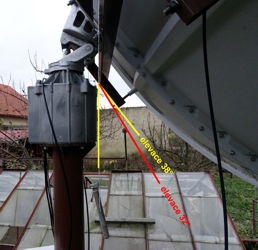Orientation of the offset dish rotated by 90 °
I would like to return to this subject once again. I already wrote that I have an offset dish placed non-standardly rotated by 90 ° at the end of the article Parameters. I also analyzed in detail the reasons for this experiment. My opinion on such a location was initially skeptical. I thought that the satellite would not be able to be aimed at all, because it would be necessary to rotate the dish in the third direction, ie to move the longer axis of the dish up and down. And the positioner does not allow movement around the front - rear axis of the EGIS.
But in the secret of my soul, I believed that it would not be necessary. Despite the initial trouble with the attempt to capture at least some signal from the satellite for the first time, described in the article Commissioning - Day One, it finally succeeded. And I gradually turned to the opposite view that there is nothing special about the direction of a parabola placed in this way. Gradually, I successfully targeted several other satellites, so I did not pay more attention to this topic.
Quite recently, I noticed that I still have a string hanging on the frame with weights from the time the dish was put into operation. Out of curiosity, I measured the angle that the string made with the frame of the parabola. It is approximately 38 °. At that moment, the dish was aimed at 28.2 ° E. To check, I checked on the DishPointer website what elevation the satellites have at this position for my geographical location. To my surprise, the elevation should be 32 °.
Fig. 1 - Difference in elevation
First I said to myself that the difference is due to a measurement error. But then I started thinking that 6 ° is quite a lot for measurement inaccuracy. So I took a picture of a frame with a string and I drew both angles in the photo. Is it possible that this is a measurement error? I do not know. Then it occurred to me to see what elevation the satellites from the position of 28.2 ° E have exactly the offset of my dish, ie 25.5 °. At the position 28.2 ° + 25.5 ° = 53.7 ° E is approximately the Express AM6 satellite (53 ° E). And it has an elevation of 23.5 ° for my geographical position. On the other hand, at the position 28.2 ° - 25.5 ° = 2.7 ° E, there is approximately the Rascom-QAF 1R satellite (2.9 ° E). It has an elevation of 31.6 ° for my geographical position.
None of these values approach my elevation of 38 °. But it is clear from these numbers that the dependence of elevation on azimuth is not and cannot be linear. Because the earth is no longer flat and therefore the height of the satellite above the curved horizon cannot be a linear function of azimuth. I probably won't find the reason for the difference of 6 ° from the correct elevation here. But I can't think of anything else yet. It would probably like to study a theory and calculate the whole thing exactly. I'll take a look when I have a moment. But you can write your expert opinions or just tips on why such a difference in elevation occurs in the comments. Maybe someone will drip on it and I won't even have to tease the samples.





